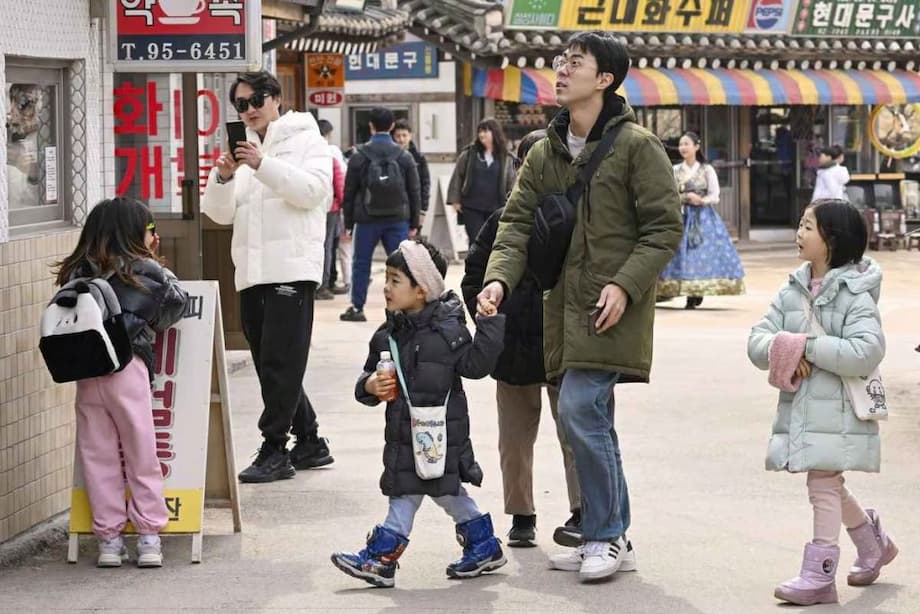A demographic turning point
South Korea is rewiring family life at a pace few nations have seen. New figures from Statistics Korea show marriages have fallen by nearly half since the mid 1990s and annual births have shrunk to roughly one third of their 1995 level. The total fertility rate, the average number of children a woman is expected to have, slid from 1.63 in 1995 to 0.75 in 2024, the lowest among advanced economies and about half the OECD average. In 2023 the rate hit a record 0.72 before edging up last year.
Those headline numbers sit alongside striking shifts in how and when families form. People are marrying later, with first weddings now concentrated in the 30s. Cross national unions are a larger share of all marriages than at any point in three decades. Births outside marriage remain rare by international standards, which ties the birth trend closely to marriage registrations. After a long slide, both marriages and births ticked up in 2024, a change officials attribute to post pandemic catch up and a larger cohort of women in their early 30s.
Demographers warn that the country has already entered a super aged era, where deaths outnumber births and the median age is rising rapidly. The demographic balance affects everything from the size of the workforce to pension math and local school closures. Policymakers are now trying to arrest the slide while preparing for the costs of an older society.
What the data shows
Statistics Korea’s historical series draws a sharp line under three decades of change. The crude marriage rate dropped from 8.7 per 1,000 people in 1995 to 4.4 in 2024. Annual marriages peaked at 434,900 in 1996, then declined to 191,700 in 2022. A small rebound arrived in 2023 with 193,700 weddings, followed by a stronger jump to 222,400 in 2024, still about 44 percent below the mid 1990s. The agency’s press releases compile the trends each year and are available at Statistics Korea.
Later marriages, fewer children
First marriages are happening later. Men marrying for the first time were on average 28.4 years old in 1995, compared with 33.9 in 2024. Women moved from 25.3 to 31.6. Parents are older too. The average age of mothers at childbirth rose from 27.9 to 33.7, and fathers from 31.1 to 36.1. Births to mothers aged 35 or older now account for 35.9 percent of the total, up from 4.8 percent in 1995. Family size has contracted. Firstborns fell from 345,800 in 1995 to 146,100 in 2024, while their share climbed from 48 percent to 61 percent. Second births dropped by about three quarters and third births by a similar share. The average interval between marriage and first birth stretched from 1.5 years to 2.5 years.
Other markers have shifted on the margins. Births outside marriage, long uncommon in Korea, increased from 1.2 percent in 1995 to 5.8 percent in 2024. Multiple births such as twins rose from 1.3 percent to 5.7 percent, a change often linked to older maternal age and wider use of fertility treatment.
Cross border unions are growing again
International marriages expanded from 13,500 in 1995, or 3.4 percent of all marriages, to about 20,800 in 2024, or 9.3 percent. Unions between Korean men and foreign women reached about 15,600, while marriages between Korean women and foreign men were roughly 5,000. International marriages peaked in 2005, then dipped, and began climbing again in 2022.
Where the decline hit hardest
The steepest birth declines over the 30 year period were recorded in South Gyeongsang Province, down about 80 percent, with Busan and North Jeolla both down about 75 percent. The Seoul capital area accounted for more than half of all births in 2024, led by Gyeonggi Province at 28 percent, followed by Seoul at 19 percent and Incheon at 6 percent.
Why many young Koreans are opting out
The statistical picture reflects deep economic and cultural constraints. Living costs are high, especially housing around Seoul, and private education is widely seen as essential. Work hours remain long by OECD standards and career breaks carry high penalties. Korea’s gender pay gap is among the widest in the developed world, and women shoulder far more unpaid care. Many young adults describe a stark trade off between a career and a family.
Sociologists and advocates also point to norms that limit alternatives. Births outside marriage are still uncommon by global standards. Same sex marriage is not recognized, and access to donor insemination for unmarried women is limited. A small but vocal 4B movement has encouraged some women to forgo dating, sex, marriage and childbirth in protest at rigid gender roles. Cash incentives alone have not shifted these choices, according to analysis from Think Global Health and other researchers.
In interviews with the BBC, women in their 20s and 30s described why they are delaying or abandoning parenthood. Yejin, a 30 year old television producer in Seoul, said the hours and expectations at work left no room for a child and added that household responsibilities would likely fall on her if she did have one.
“Working in Korea is hard, you’re stuck in a perpetual cycle of work.”
The dynamics show up in how parental leave is used. Both parents are entitled to take leave during a child’s early years. Yet in 2022 only about 7 percent of new fathers took any leave, compared with about 70 percent of mothers, a gap that reinforces the idea that care is mainly women’s work. Many women fear career damage if they step back, a pattern that research by the OECD says keeps fertility low and pushes some out of the labor force.
President Yoon Suk Yeol has called the situation a national emergency and said earlier pronatalist spending had not worked. He described Korea as excessively and unnecessarily competitive, and ordered policies that treat low birth as a structural problem rather than a short term aberration.
Are policies starting to move the needle
After years of decline, the numbers turned slightly in 2024. Marriages increased for a second straight year to 222,400. Births rose to about 238,000, up from a record low the year before, and the fertility rate nudged up to 0.75 from 0.72. Officials point to a clear link between marriage and birth. Around 95 percent of births in South Korea occur within marriage, so wedding trends often foreshadow the birth count.
Catch up and a larger cohort of women in their early 30s
Several near term forces are at work. Marriages and births that were delayed during the pandemic are being registered. The population of women aged 30 to 34 is temporarily larger, reflecting an echo of the early 1990s baby boom. Monthly data show the shift. In April 2025, births rose 8.7 percent year on year to 20,717, the fastest monthly gain in 34 years, as marriage registrations posted a 13th straight month of growth. The first quarter of 2025 saw a 7.3 percent rise in births compared with a year earlier.
Cash, care, and culture
Successive governments have spent hundreds of trillions of won on family support, including child allowances, housing benefits, IVF coverage for married couples, expanded daycare, and longer paid parental leave. New initiatives added in 2024 and 2025 extend paternity leave, introduce flexible schedules, and target newlyweds with loans and housing. Local governments and companies are experimenting with dating events and other social nudges. Researchers caution that subsidies raise income but do little unless work culture changes, caregiving is shared more equally, and the education arms race eases. The OECD makes similar points in its analysis of Korea’s low fertility.
Economists caution that a temporary rebound does not mean the problem is solved. Hong Sok chul of Seoul National University told local media that cost cutting alone would not suffice.
“There needs to be effort to solve structural social problems,”
International outlets and demographers share the caution. Deaths still exceed births, the fertility rate is far below replacement level, and the number of women of childbearing age continues to shrink. The risk is that any rebound is brief unless deeper constraints ease.
International marriages and the role of immigration
One of the few areas of sustained growth is international marriage. Cross border unions accounted for about one in eleven marriages in 2024, up from about one in thirty in 1995, with a renewed increase since 2022 after an earlier mid 2000s surge and subsequent pullback. The pattern reflects both personal choice and economic reality, including long standing imbalances in rural marriage markets.
Immigration is increasingly part of the demographic conversation. Policy reviews by researchers and organizations such as Think Global Health and the OECD argue that a larger inflow of foreign workers and families could help sustain the labor force and support an aging population. Even with a higher fertility rate, the pool of women in their 20s and 30s will be smaller in the coming decades. Managed immigration, combined with better support for multicultural families already in Korea, can ease the transition while society adapts.
Making multicultural families feel at home
Experts say that targeted language programs, school support, and protection against discrimination can help children in multicultural households thrive. Companies and local governments that invest in inclusion can widen the pool of potential workers and community leaders. That approach will matter more if international marriages keep rising and if the country relies on immigration to fill gaps.
The economic and social stakes
Without sustained change, the numbers point to a smaller, older Korea. The OECD estimates that the population could halve over the next six decades if fertility stays low and immigration remains modest. The share of seniors is likely to climb toward 60 percent by the 2080s. The old age dependency ratio will rise, straining pension systems and long term care, and narrowing the tax base.
Local evidence is already visible. Schools in some regions have merged or closed. Health and welfare budgets are climbing faster than revenues. Employers face worker shortages in care, construction, and advanced manufacturing, even as youth unemployment and underemployment coexist with long screening periods for elite jobs. Families often talk of the crushing costs of housing and tutoring, a pair that discourages larger families.
The mood has grown somber enough to travel beyond statistics. In a 2023 documentary on Korea’s public educational broadcaster, the American legal scholar Joan C. Williams reacted bluntly to the fertility numbers.
“South Korea is so screwed.”
Her remark captured how quickly the demographic math became a mainstream concern. The hard work now sits with policymakers, employers, schools, and families to reduce the costs and risks of having children while respecting personal choice.
What could change the trend
Experts have identified a toolkit that works best as a package, not a list. Shorter working hours, predictable schedules, and meaningful flexibility let parents keep careers on track. Paternity leave that is both well paid and widely used helps close the care gap at home. Reliable daycare with long hours reduces the need for grandparents or private tutors. Housing policy that lowers entry costs for young couples, especially near jobs, reduces anxiety.
Education reform is another lever. Policymakers can expand after school programs, raise school quality outside top districts, and discourage excessive private tutoring that drains household budgets. If parents no longer feel a need to purchase expensive cram school hours to keep a child on track, the perceived cost of a second child falls.
Gender equality is the hinge. Stricter enforcement against discrimination during and after parental leave, fairer pay structures, and promotion paths that do not punish time away would signal that having a child does not end a career. Some analysts argue for reserving parts of leave for fathers on a use it or lose it basis, as in France and the Nordics, which has been shown to raise male uptake.
Financial support still matters. The new administration has floated ideas such as large low interest loans for newlyweds with debt forgiveness tied to children, expanded allowances up to age 18, and tax reforms that lower the burden for larger families. Those benefits are easiest to justify if coupled with work and school reforms that address the reasons young people hesitate.
Immigration and inclusion can complement these steps. A predictable path for skilled and essential workers, and support for their families, will make it easier to maintain economic dynamism while domestic births remain low. Policymakers can also update rules that limit family formation options, including barriers to assisted reproduction for unmarried women, which would help align law with lived reality.
Key Points
- Marriages in South Korea have fallen by about half since the mid 1990s, then rebounded to 222,400 in 2024.
- Births dropped from 715,000 in 1995 to about 238,000 in 2024, with the total fertility rate rising slightly to 0.75 from a record low of 0.72 in 2023.
- Marriage now happens later, and parents are older; births to mothers aged 35 and over rose to 35.9 percent of the total.
- Firstborns make up a larger share of births while second and third births have fallen sharply; the marriage to first birth gap has lengthened to 2.5 years.
- International marriages rose to 9.3 percent of all unions in 2024, with renewed growth since 2022.
- Births are still concentrated in the Seoul region, while provinces such as South Gyeongsang, Busan, and North Jeolla recorded the steepest declines since 1995.
- High housing and education costs, long work hours, and a wide gender pay gap are key reasons many young adults delay or avoid marriage and parenthood.
- Government spending and new policies have expanded parental leave, childcare, and housing support, yet analysts say deeper changes in work culture and gender norms are essential.
- Monthly data show an uptick in late 2024 and early 2025, driven by post pandemic catch up and a larger cohort of women in their early 30s, but sustainability is uncertain.
- Experts recommend a combined approach: flexible work, equal caregiving, affordable housing and schooling, targeted financial support, and a pragmatic immigration strategy.




